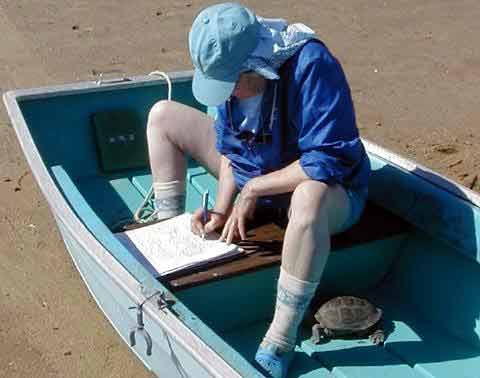On the Move — 9 June 2001
Some days swirl while others laze. Today fell on the swirl size of the continuum. Morning began with turtles shooting the rapids of Blackfish Creek as a 2-knot current drained their marsh habitat. Two old friends passed through the rip. Terrapin 33 was first observed as 7-year-old pre-pubescent female in 1989, measuring a mere 15.1 centimeters and weighing only 371 grams. Today she’s a mature turtle and one of the larger females in Wellfleet at 20.4 centimeters and 1500 grams. Turtle #283 was first marked as a mature 12-year-old nesting female in 1992. Since then she’s added another centimeter of growth and 100 grams of weight. Neither exhibited palpable signs of gravidity. They were joined this morning by 1103, a mature male of undetermined age, and 1104, a 6-year-old immature female. Coincidentally, these last two measured precisely the same length 11.66 centimeters. The male weighed 260 grams and the female 300.

Not everyone seemed in a hurry to get moving. The young female (1104) decided to hide under the kayak when released, rather than scrambling to the water with her comrades. This behavior, hiding under the boat or some nearby object, seems more prevalent in juvenile terrapins.

With this evening’s high tide, we began nesting checks to look for that first nester of the season. As we rounded Turtle Point on south Lieutenant Island, I spotted a female head in a flooded tidal pool and creek channel about 500 feet into the marsh. I circled around to approach the area from bayside to get between her and open water. As I approached the channel, a previously unobserved male surfaced, took one look at me (and my trusty net), and decided the better part of valor called for flight rather than fight. He gulped air, kicked, and scooted for the bay, leaving his sweetheart to fend for herself.
Terrapin 223 was deeper into the creek and decided to evade capture by hiding in its murky marsh thickets. It nearly worked since the creek was bracketed by oozy mud banks and its bottom consisted of quick mud. But hey — if you’re not getting dirty, you’re not having fun. I did and I did. Number 223 is an old friend of the research program, first captured as a juvenile in the summer of 1990. She was last seen on a nesting run in this same creek channel on 18 June last year.

We’re still waiting for the season’s first nester. A volunteer called this evening to report what may have been scratchings of a false nest on Indian Neck. With high tides on Monday, Tuesday, and Wednesday coinciding with dawn, it would be a sound bet that the nesting season is about to kick off — with gusto. Volunteer extraordinaire Liz Moon arrived from the mainland in time to join this morning’s roundup. Working on her second decade of terrapin research with Mass Audubon. Liz returns each spring to document nesting turtles in Wellfleet Bay.

|